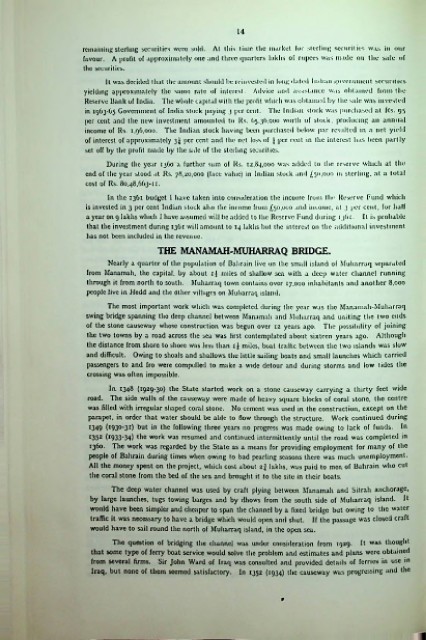Page 366 - Bahrain Gov Annual Reports (II)_Neat
P. 366
14
remaining sterling securities were sold. At this time the market for sterling securities was in our
favour. A profit of approximately one and three quarters lakhs of rupees was made on the sale of
the securities.
It was decided that the amount should he reinvested in long dated Indian government securities
yielding approximately the same rate of interest. Advice and assistance was obtained from the
Reserve Bank of India. The whole capital with the profit which was obtained by the sale was invested
in 1963-05 Government of India stock paying j per cent. The Indian stock was purchased at Ks. 95
per cent and the new investment amounted to Rs. 65.36,000 worth of stock, producing an annual
income of Rs. 1,96,000. The Indian stock having been purchased below par resulted in a net yield
of interest of approximately 3J per cent and the net loss of J per cent in the interest has been partly
set off by the profit made by the sale of the sterling securities.
During the year 1360 a further sum of Rs. 12,84,000 was added to the reserve which at the
end of the year stood at Rs. 78,20,000 (face value) in Indian stock and £50,000 in sterling, at a total
cost of Rs. 80.48.663-11.
In the 1361 budget I have taken into consideration the income from the Reserve Fund which
is invested in 3 per cent Indian stock also the income from £50,000 and income, at 3 per cent, for half
a year on 9 lakhs which I have assumed will be added to the Reserve Fund during 1361. It is probable
that the investment during 1361 will amount to 14 lakhs but the interest on the additional investment
has not been included in the revenue.
THE MANAMAH-MUHARRAQ BRIDGE.
Nearly a quarter of the population of Bahrain live on the small island of Muharraq separated
from Manamah, the capital, by about ij miles of shallow sea with a deep water channel running
through it from north to south. Muharraq town contains over 17,000 inhabitants and another 8,000
people live in Hedd and the bthcr villages on Muharraq island.
The most important work which was completed during the year was the Manamah-Muharraq
swing bridge spanning the deep channel between Manamah and Muharraq and uniting the two ends
of the stone causeway whose construction was begun over 12 years ago. The possibility of joining
the two towns by a road across the sea was first contemplated about sixteen years ago. Although
the distance from shore to shore was less than ij miles, boat traffic between the two islands was slow
and difficult. Owing to shoals and shallows the little sailing boats and small launches which carried
passengers to and fro were compelled to make a wide detour and during storms and low tides the
crossing was often impossible.
In 1348 (1929-30) the State started work on a stone causeway carrying a thirty feet wide
road. The side walls of the causeway were made of heavy square blocks of coral stone, the centre
was filled with irregular shaped coral stone. No cement was used in the construction, except on the
parapet, in order that water should be able to flow through the structure. Work continued during
x349 (I930_3r) but in the following three years no progress was made owing to lack of funds. In
I352 (r933"34) the work was resumed and continued intermittently until the road was completed in
1360. The work was regarded by the State as a means for providing employment for many of the
people of Bahrain during times when owing to bad pearling seasons there was much unemployment.
All the money spent on the project, which cost about 2\ lakhs, was paid to men of Bahrain who cut
the coral stone from the bed of the sea and brought it to the site in their boats.
The deep water channel was used by craft plying between Manamah and Sitrah anchorage,
by large launches, tugs towing barges and by dhows from the south side of Muharraq island. It
would have been simpler and cheaper to span the channel by a fixed bridge but owing to the water
traffic it was necessary to have a bridge which would open and shut. If the passage was closed craft
would have to sail round the north of Muharraq island, in the open sea.
The question of bridging the channel was under consideration from 1929. It was thought
that some type of ferry boat service would solve the problem and estimates and plans were obtained
from several firms. Sir John Ward of Iraq was consulted and provided details of ferries in use in
Iraq, but none of them seemed satisfactory. In 1352 (1934) the causeway was progressing and the

